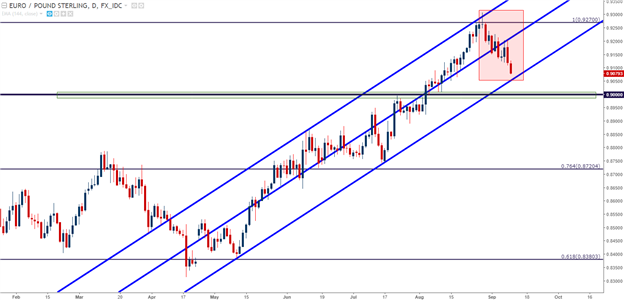Last week closed on a sour note for the U.S. Dollar, as the currency continued the 2017 down-trend after having set a fresh 2.5 year low earlier on Friday morning. This extends the U.S. Dollar’s downside run beyond the 12% marker for this year, and even a dovish ECB meeting last week was unable to reverse the trend, as Euro bulls ran through Mario Draghi’s dovish comments in anticipation that the ECB will inevitably need to push policy into a less loose state before the end of the year.
But while much of the world was watching the Euro or the Dollar, something interesting began happening under the surface, and that’s a firm bout of strength beginning to show in the British Pound. While the Euro strengthened against the Dollar and the Yen last week, strength in GBP far outpaced what was seen in the single currency, and EUR/GBP has retraced approximately 220 pips since setting a fresh high no more than two weeks ago. This exposes the psychological level of .9000 in EUR/GBP for potential support plays, and this helps to show how aggressively Sterling bulls have been pushing the envelope so far in September.
EUR/GBP Daily: September Retracement Exposes Potential Support at .9000-handle

Chart prepared by James Stanley
On Friday, we discussed what may be behind this current run of GBP-strength, and this is likely very similar to something that we saw earlier in the year, when markets were bidding the Pound-higher in anticipation of the Bank of England tweaking policy to be less loose in order to account for rising inflation within the economy.
This was something that we knew going into Brexit, and we warned of as such by BoE Governor Mark Carney. Ahead of the referendum, Mr. Carney said that a decision to leave would entail a sharp repricing in the value of the British Pound, which could lead to higher levels of inflation, higher levels of unemployment and slower levels of growth as the country waded through Brexit negotiations. This would put the Central Bank in the unenviable position of having to choose a path: Either tighter policy to rein in inflation, which could potentially hit both jobs and growth. Or, loosen policy to support growth and employment, even at the behest of heavier levels of inflation down-the-road. It wasn’t more than a week after the referendum that the BoE showed their hand, warning that they were prepared to launch a bazooka of stimulus to further support the British economy before Brexit discussions got underway.













Leave A Comment